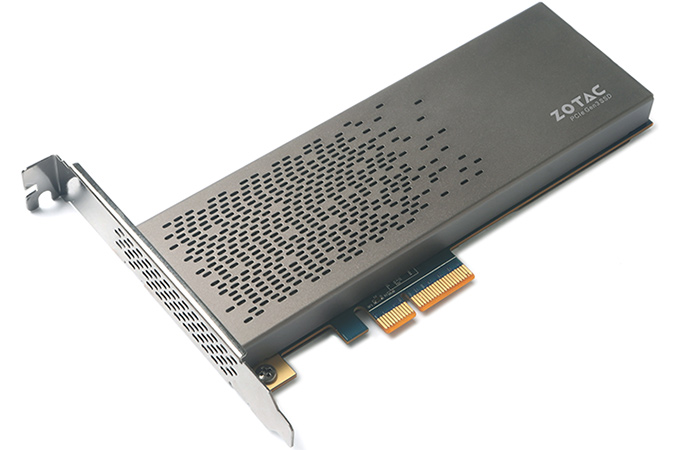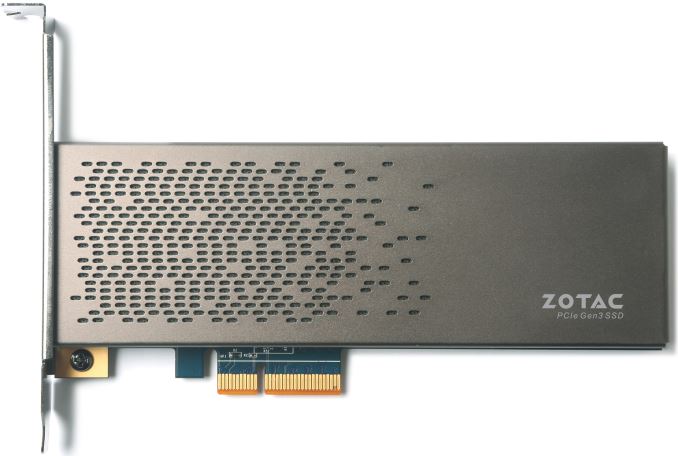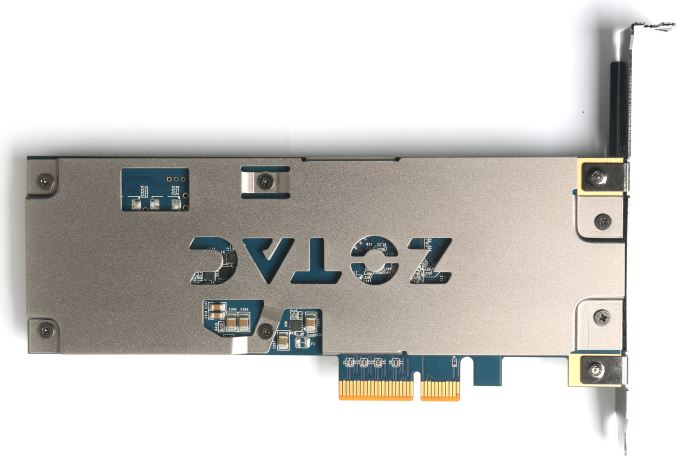ZOTAC Announces SONIX PCIe SSD Price & Availability
by Anton Shilov on March 2, 2016 2:00 PM EST
ZOTAC has formally announced its PCIe SONIX SSD, which was first demonstrated at CES earlier this year. Confirming the final specifications and design, the company said that the new drive would be available in the middle of this month at a price-point comparable to that of other PCIe-based SSDs. The availability of the ZOTAC SONIX will mark the arrival of a new breed of high-performance PCIe SSDs based on the Phison PS5007-E7 controller.
The final version of the ZOTAC SONIX will be faster than the preliminary version of the SSD demonstrated at CES, with the shipping version rated for sequential read performance of 2600 MB/s and sequential write performance of up to 1300 MB/s. The initial flavor of the ZOTAC SONIX SSD will offer 480 GB capacity, will be equipped with 512 MB of DDR3 DRAM cache and will come in half-length half-height PCI Express 3.0 x4 card form-factor. The drive will consume 5.57W when performing read operations, 7.27W while writing and 0.5W in idle mode, according to the supplier.
| ZOTAC SONIX PCIe SSD Specifications | |||
| 480 GB | |||
| Controller | Phison PS5007-E7 | ||
| NAND | Toshiba MLC | ||
| DRAM Cache | 512 MB DDR3 SDRAM | ||
| Sequential Read | 2600 MB/s | ||
| Sequential Write | 1300 MB/s | ||
| Active Power (Read/Write) | 5.57 W/7.27 W | ||
| Idle Power | 0.5 W | ||
| Encryption | AES-256 | ||
| MTBF | 2,000,000 hours | ||
| Interface and Form-Factor | PCIe 3.0 x4 HHHL card | ||
The ZOTAC SONIX SSD will be among the first solid-state drives to use Phison’s PS5007-E7 controller demonstrated in mid-2015. The chip fully supports NVMe 1.2 protocol, error correction with 120-bit/2KB BCH code, NVMe L1.2 power saving mode, end-to-end data path protection, advanced global wear-leveling, an AES-256 engine and so on. The PS5007-E7 has eight NAND flash transfer channels and can perform up to 300K random read IOPS (input/output operations per second) as well as 200K random write IOPS. As we reported back in January, the PS5007-E7 had been finalized and the final firmware was due in February.
As expected, the ZOTAC SONIX drive will use Toshiba’s multi-level cell (MLC) NAND flash memory and will be positioned as ZOTAC’s premium offering. The product will hit the market in mid-March at the price of $369.99, which is comparable to that of Kingston’s HyperX Predator M.2 480 GB SSD ($364.99) as well as Samsung’s 950 Pro M.2 512 GB SSD ($327.99).
It should be noted that Phison not only develops controllers, but sells packages consisting of a controller, NAND flash memory, firmware and even production services. The majority of Phison-based SSDs are made by a contract manufacturer under supervision of the controller developer. While the approach somewhat constraints innovation of SSD suppliers because drives based on the same Phison controller offer similar feature-set and performance, it also guarantees relatively high quality, competitive pricing and broad availability.
If ZOTAC starts to ship its SONIX PCIe SSD in mid-March, other partners of Phison, including Corsair, Kingston, Mushkin, Patriot, PNY and other will likely follow shortly. As a result, the market should have a significant number of PCIe 3.0 x4 and M.2 SSDs with up to 2600 MB/s sequential read performance based on MLC NAND memory. Competition between various suppliers will naturally affect prices of actual products, which is good for the end-user. Keeping in mind that Samsung’s 950 Pro M.2 512 GB SSD already costs $328, it looks like prices of high-end PCIe NVMe SSDs this year will get very competitive. Moreover, when and if new SSDs based on SandForce's SF3500 controller arrive, things will get even more intense.
Source: ZOTAC


















21 Comments
View All Comments
bill.rookard - Wednesday, March 2, 2016 - link
I'm curious as to how these drives would present themselves to the bios. I know that the M.2 type drives are already supported by the bios, but I've got an older LGA1156 motherboard (Asus P7F7-e) which full quad-SLI support as it is a full blown workstation board (and a very nice one too).My question is - I'm already planning on a SLI setup using two of those slots. If the PCIe drives come out and become affordable, I'm wondering how a pair of those would fare in RAID 0 for a boot drive... If they come up as a normal, bootable drive to any BIOS, then it -should- be configurable by the onboard RAID.
Ooooh that would be just sick.
Kardax - Wednesday, March 2, 2016 - link
At this level of performance, you're going to be CPU-limited, not I/O limited, for nearly any non-benchmark activity.bill.rookard - Wednesday, March 2, 2016 - link
You're probably correct, as that is a metric sh*t ton of data to move around, but it would still be very interesting to see. The CPU I'm currently running in the board is a Xeon X3470 overclocked to 4.0ghz.It's pretty quick. :)
Stan11003 - Monday, April 18, 2016 - link
DDR3-1600 transfers at 12,800 MB/s per DIM and DDR4-2400 can 19.2 GB/s. If your CPU can handle that then it can handle SSDs. Some crazy people have Raided two SM951 together and have gotten 4.5 GB/s. You'll reach PCIe limitations before you over load the CPU.fallaha56 - Wednesday, March 2, 2016 - link
sorry to rain on parades but you'll find you can't easily RAID -at least not for a boot drivetotally with you in principle tho...
gtxx - Wednesday, March 2, 2016 - link
Yes you can, its not easy but its not impossible. You need to raid the drives under firmware raid or IRST, then when you go to install windows you need to install either the chipset raid drivers or IRST drivers and then you're good to go. I recently did this with a laptop (kill me plz) because the user wanted "the best of the best".....AppleJon - Wednesday, March 2, 2016 - link
Probably two sata M2 drives not pcie drive. The sata port goes to the chipset witch support raid function. The pcie can be direct from the cpu so no raid exept in os level software after post/boot. So no he did not get best of the best. And at these speed latency probably more important the bandwith so raid would probably make things "slower"wolrah - Friday, March 4, 2016 - link
Intel's onboard RAID solution supports NVMe drives on Z170s. I don't know if that support has been backported, but at least those with the latest generation Intel systems can do it.My Z97 board supports NVMe booting, but I think its RAID is just for SATA. I haven't tested because I think motherboard RAID is stupid.
Ryan Smith - Wednesday, March 2, 2016 - link
A board that old would not support native booting from an NVMe drive. Though it would be easy to put the Windows bootloader on a SATA drive and have it hand off to an NVMe drive.joex4444 - Wednesday, March 2, 2016 - link
How would you expect the two drives to talk to each other? They're in separate PCIe slots and not part of the SATA interface so the BIOS can't enable RAID there. The most you could do is software RAID which is feasible for Linux/BSD.